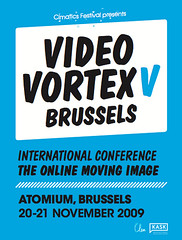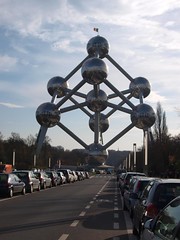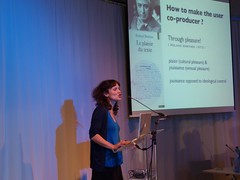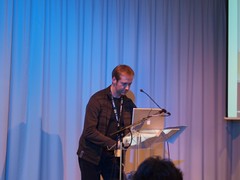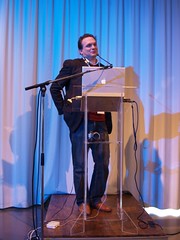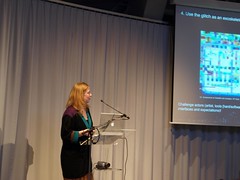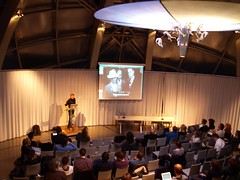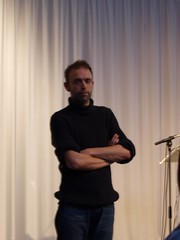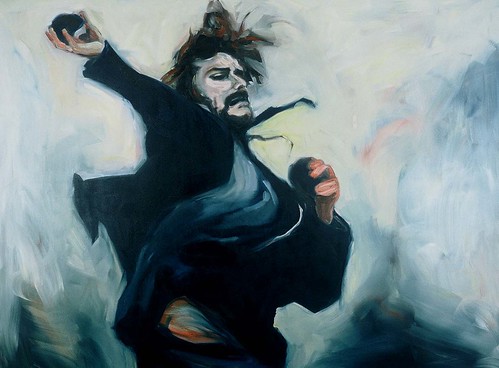Interpreting urban screens
Anthony Auerbach
Abstract
Large-scale video screens in urban settings suggest new possibilities and challenges for city authorities and regulators, architects, advertisers and broadcasters as well as for cultural curators and producers. While this potential remains largely untested, it is clear that urban screens establish new sites for the negotiation between commercial, public and cultural interests. This paper takes a critical approach to the question of defining the role of culture in urban media, highlighting the shifts in the relations of representation mediated by video and the complexity of the urban media environment.
Location
The conference ‘Urban Screens’[1] aimed to explore the potential of large-scale video screens in public places as venues for artistic and cultural programming. My contribution sketched a critical approach which did not start out with simplistic notions such as ‘electronic billboard’, ‘outdoor TV’ or ‘public art’. I aimed to locate large-scale video installations in the spectrum of television and video networks which populate and, increasingly, construct the urban fabric. The photographic documentation which accompanied my talk (and which accompanies this article) is an inventory of the urban phenomena of video familiar to everyone. It demonstrates how a small set of technologies supports a large set of applications at different scales: from the infrastructure of terrestrial, satellite, cable and mobile networks, through the equipment of the home, the workplace, commercial and public spaces, to systems of surveillance and control. Each photograph offers a document which would repay analysis, tracing the web of interactions between of media and architecture, subject and commodity, identity and desire, the city and its phantasmagoria.
My starting point, ‘Video as Urban Condition’[2] is the working title of an exhibition and archive project which begins as an inquiry into how video shapes urban experience.
Fascination
The fascination of urban screens — like that of television when it appeared in the twentieth century — is the allure of a medium in search of a message, with the potential to create audiences. The large-scale LED video screens which are becoming an increasingly common sight on the urban landscape have been put there principally for advertising, information or entertainment. In practice, the installations have usually combined all three purposes in various proportions and sometimes admitted other content such as artists’ videos or interactions with members of the public. Urban screens are made possible when the interests of those who control the exhibition space, the technology, the potential content streams and the potential revenue streams converge. Urban screens today are experimental enterprises. Emerging in complex environments, urban screens will challenge the assumptions of artists, curators, urban- and media theorists as well as the expectations of city authorities, advertisers and broadcasters.
Subjectivity
Whereas the discussion of ‘urban screens’ has been dominated by screen technology and what could or should be done with it, mainly from the point of view of professional producers, I would like to emphasise the multiplicity of subjectivities implicated by video in urban environments. ‘Video as Urban Condition’ aims to explore how our knowledge, perception and fantasy of urban environments are mediated by video. That means understanding not only the influence of the flickering screens which surround us, but also the image-world of the city transmitted, for example, by TV drama or by the urban playgrounds of video games such asSimCity or Grand Theft Auto. The games, moreover, assert the position of the viewer as the first person subject acting on or in the virtual city. Similarly, with the spread of consumer-level camcorders and video-equipped mobile phones, it is important to acknowledge how the subject of ‘video’ (‘to see’) is the one who holds the camera as much as the one who watches the screen (even — especially — if in the act of recording, the two cannot be separated). Video has become a medium of mass-production — that is, mass-participation — as well as mass-consumption.

Figure 1: Rome, 2005: This act of video recording dislodges the traditional custom and saves a coin.
Video is no longer the exclusive domain of professionals. Video offers the tourist, for example, a means of both mediating consumption (of technology and of travel) and authenticating experience (even when the preoccupation with filming would seem to compromise the experience promised by the idea of travel). One could also argue that, despite the aura which clings to the profession ‘artist’, the way artists use video has more in common with the amateur than with the professional broadcaster or film-maker.
Origins
Which brings me to the origin of ‘Video as Urban Condition’ as a project: against the background of the myriad uses of video in daily life, the effort to assimilate and contain video within the norms and institutions of art (and thereby to defend the status of the artist as such) begins to seem absurd. We are accustomed to the idea that video images assert a multitude of different claims, that the same LCD, LED or plasma screens, cathode ray tubes or projectors convey a multitude of different messages and will ambush us in almost any location. To be sure, the video screen captures eyeballs, but does not by itself dictate a particular mode of viewing in the way the traditional media, framings and settings of art works instruct the viewer to adopt an appropriate mode of reverent attention. With video, we are capable, indeed trained, to adjust our subjectivity, perception and receptivity instantaneously — almost continuously — as quickly as we flip the channels with a remote control, or, for that matter, as we walk down a commercial street.
This condition seemed to me to present a more exciting set of possibilities for producing and showing videos than the battle for artistic credibility. What strategies would emerge if we could create the chance for artists to make use of the existing video infrastructure? In other words, not to offer a TV set on a plinth in a white cube or a projection in a black box, but instead to remove the protection of such institutions, expose the work in urban space and accept this less reliable frame; to accept that video will not support an artist’s claim to exceptional status or of itself command respect.
That seemed like a good idea and I began to investigate the practical possibilities. It will be no surprise to you, that in probing the structures which regulate public space and artistic production, I soon discovered the naivety of my proposition. Hence the need to interpret the site-specific nature of urban video installations and to understand what I have called the relations of representation.
Dialectics
To interpret ‘urban screens’ and assess their potential, it seems to me vital to acknowledge the dialectics of screens, that is, their double and contradictory functions. Broadly understood, a screen is there to display something, but also to conceal something. A screen acts only as ifit were a passive receiver of an image — as some would have it, merely the reflection of the society in which it is found. In the urban context especially, it is also a transmitter. As one agency claims, outdoor advertising is the ‘last remaining truly broadcast medium.’ (ClearChannel, 2005)[3]
Considering the relations of representation, we could ask: What is the ideological function of the screen? In other words: What and whose assumptions are concealed by the screen? Many speakers at the ‘Urban Screens’ conference invoked the notion of ‘public art’, but without suggesting that there is any agreement about how artists and public identify themselves or one another, by whom, and by means of what technology and what institutions this relationship is mediated. Instead of assuming, as the original call for papers seemed to suggest, that urban screens are culturally deprived spaces which need to be served by self-styled cultural producers and curators, we could ask: Who says what is culture?
In Manufacturing Consent, Chomsky and Herman discuss the notion of culture which is propagated by broadcast media in the United States. They write:
There are exceptional cases of companies willing to sponsor serious programmes, sometimes the result of recent embarrassments that call for a public-relations offset. But even in these cases the companies will usually not want to sponsor close examination of sensitive or divisive issues — they prefer programmes on Greek antiquities, the ballet, and items of cultural and national history and nostalgia. Barnouw points out an interesting contrast: commercial-television drama [i.e., soap operas] ‘deals almost wholly with the here and now, as processed via advertising budgets,’ but on public television, culture ‘has come to mean “other cultures.” … American civilisation, here and now, is excluded from consideration.’ [Barnouw, 1978, p. 150]
Television stations and networks are also concerned to maintain audience ‘flow’ levels, i.e., to keep people watching from program to program, in order to sustain advertising ratings and revenue. Airing program interludes of documentary-cultural matter that cause station switching is costly, and over time a ‘free’ (i.e., ad-based) commercial system will tend to excise it. Such documentary-cultural-critical materials will be driven out of secondary media vehicles as well, as these companies strive to qualify for advertising interest, although there will always be some cultural political programming trying to come into being or surviving on the periphery of the mainstream media. (Chomsky and Herman, 1988, p. 18)
Many of the ‘cultural’ initiatives we heard about during the conference appeared to reassert this model, that is, the tendency towards displaying ‘culture’ as if it were separate from the conditions of its reproduction, and the acceptance of a marginal position. At least, this appeared to be the basis for the alliances between cultural workers and corporate sponsors, technology providers and media- or advertising agencies in developing cultural programmes for urban screens.[4] At most, culture provides a utopian affirmation of the power relations which govern public- and media space. Indeed, one could argue that such affirmation helps to define, secure and defend the realm of culture as such.
From this perspective, it is not really these power relations which are hidden by the screen. When you look, for example, at the ‘Big Screen’ in Manchester’s Exchange Square (which, incidentally, carries no advertising in its programme) you see that the logos of the local authority, the Royal Bank of Scotland, the BBC and Philips are permanently branded on the installation. What is concealed by large-scale video screens in public places, one could argue, are precisely the shifts in the relations of representation which have occurred since Chomsky analysed network television.
There is not enough space to develop the argument fully here, but I would like to make two comments which suggest how the analysis could go: one about the role of video in conditioning urban space and urban subjects; the other about communications technology and the privatisation of public space.
Producing and seducing a public
The multiplication of channels in the home which seemed to threaten the cohesion of television’s audience and its status as a mass-medium prompted advertisers and broadcasters to target their audiences in public. However, in taking TV from point-of-sale installations and the captive audiences of station platforms, airports, queues and waiting rooms into ‘public space’ means entering more complex urban environments. It means facing the decline of urban community spaces which, since the 1950s, has often been blamed on television. ‘Public space broadcasting’[5] is a meaningful proposition only if it can produce a public. This requires not just programming a screen, but all the forces of urban planning, architecture, policing and so on.
The role video surveillance in this process hardly needs to be underlined. CCTV is perceived to be the ideal means of making cities safe, in other words: of excluding ‘undesirables’ from specific places and helping to moderate the behaviour of individuals. What I would like to point out is how video display and surveillance installations can work together in the so-called regeneration of public space.
Surveillance and display both have a share in the fascination of television, that is, its ability both to connect the viewer to a distant place and to distance the viewer in the present location. As part of the apparatus of controlling urban spaces, video surveillance facilitates the ways in which a video display can assemble, interpellate and commodify a public. In turn, the fascination projected by display facilitates the acceptance of video surveillance by seducing the individuals under surveillance with their own images on screen — permitting individuals the voyeuristic pleasure of seeing themselves where they stand — at a distance. The ‘narcissism’ of the Exchange Square audience was mentioned as a key factor in successful programming for that public screen. This narcissism is echoed whenever we walk under the monitor placed at the entrance to a shop or station to reassure those it welcomes and warn those it excludes with the announcement: You are being watched. TV still flatters, even without the promise of fame.
The private in public
Large-scale video screens tend to adopt modes of address which are familiar from television, outdoor advertising or the cinema. Each has its history and retains some of its rhetorical force, but all are increasingly undermined by the integration of entertainment, information and mobile communications technology. ‘Public space’ as the natural environment for one-to-many communications and the shared spectacle is now intersected by private and personal channels: connecting you to your choice of media streams , to other individuals in other places, or simply immersing you in the interior urban movie produced with the soundtrack of a portable music player.

Figure 2: New York City, 2005: A momentary story-within-a-story on a public urban screen
Big screen initiatives have emerged which invite you to use your mobile phone to display poems, photographs or messages, to vote or bet on what you see. The efforts of commercial and cultural producers alike to incorporate mobile communications technologies into the big screen appear to be motivated by the anxiety to bind the potentially autonomous user to its regime. For a while, the screen becomes the audience. It receives your message or image and projects a flattering notion of public address. The ‘interactive’ message, like the radio dedication, still goes out only to ‘friends and family’, whom you could contact directly whenever you want.
At the same time, electronic ‘interactivity’ divides the audience into those who have, and those who do not have access to the technology. It flatters the haves (while, if possible, harvesting data) and advertises the product to the have-nots. For increasingly integrated media and communications corporations there is no conflict in using the public screen to promote the private consumption of video in public places, just as broadcasters frequently use the screens in public places to advertise what they have to offer the home viewer.
Potential
At the end of her book Ambient Television: visual culture and public space, Anna McCarthy reflects:
The TV screen embodies all the political contradictions that come with art in public spaces, as well as those more particularly associated with television. As a public medium governed by private logics, as a private medium that comes to stand in for the public it addresses, as a private, domesticated possession that regularly appears in, and alters, public places, television spans utopia and critique as it brings modes of spectatorship into the illegible terrain of the everyday. These video installations … involving TV’s commercial logics in a dialogue with radical alternatives to consumerism[6] [provide] us with provocative and instructive inkblots not for thinking about how to begin making rapprochements between utopian and critical ideas about TV, social change, and public space but for recognizing and exploiting how much these rapprochements are already available in the spaces of everyday life. This means taking seriously the site-specific power relations which become visible in ambient television installations. Only then can we devise policies, programs, and practices that develop these ideas about sociality and collectivity that TV’s presence in such places raises. (McCarthy, 2001, p. 251)
In my view, discovering the potential of urban screens also means taking seriously the inattentive viewer, the perpetually distracted subject which video and the city have created.
Consumer culture is often blamed for the homogenisation of urban experience, through domination of global brands and the insidious effects of the entertainment industry and media corporations. Video is at the heart of this process and is perhaps the pre-eminent means of propagating norms. Video has also produced the subjective hybrids which we know as infotainment, docudrama and reality-TV as well as the many unnamed alterations of perception and behaviour mediated by the video screen. Such alterations certainly influence, but do not necessarily bind the ever-growing number of people who are video-makers. The distribution of video technology suggests the possibility engendering as many approaches as there are users. Among them, perhaps, ways of contesting the conventions and habits which video persuades us are second nature, and means of making the specificities of urban experience perceptible.
About the author
Anthony Auerbach’s work revolves around the critique of knowledge and representation. Like drawing, which is at the heart of Auerbach’s artistic practice, video is a medium which cannot be claimed exclusively by art and therefore calls for an interdisciplinary approach. As initiator and director of the project ‘Video as Urban Condition’ (2004–), Auerbach brings together a range of interests and concerns: interpreting relationship between video, architecture and urban geographies (following his MA studies and his involvement in teaching architectural design); critical models for the understanding the relationships between technology and representation (following his PhD study ‘Structural Constellations’); practical and collaborative models for work in public (following his involvement in devising and curating exhibitions and events).
E-mail: contact [at] video-as [dot] org
1. Urban Screens: discovering the potential of outdoor screens for urban society’, Amsterdam 23–24 September 2005. An international conference organised by Mirjam Struppek in co-operation with the Institute of Network Cultures (Department of Interactive Media at the Hogeschool van Amsterdam) welcomed a wide range of speakers to discuss the uses of large-scale LED screens ‘that increasingly influence the visual sphere of our public spaces in urban settings’. In the words of the organisers, the conference would ‘investigate how the currently dominating commercial use of these screens can be broadened and culturally curated. Can these screens become a tool to contribute to a lively urban society, involving its audience interactively?’ Contributions from academics, curators and artists were complemented by talks by architects, technology providers, advertising agencies and broadcasters.
3. Clearly, that also applies to billboard-sized LED screens, although it will be interesting to see what influence the increasing segmentation of air time on such screens will have in the future.
4. Chomsky and Herman do not point out that when advertising itself becomes the chief cause of ‘switching’, then cultural matter can present itself again as a means of binding the audience to the flow. On a commercial channel, cultural matter has the ambivalent status of advertising the fact that there remains unsold air time.
5. This is what the BBC calls its project, and in so doing expresses a ambition shared by commercial operators.
6. McCarthy has just discussed two video works in public places: a self-organised intervention by TWCDC (Together We Can Defeat Capitalism) in which the activist group paid $800 to insert a message in the San Francisco public transport information system, and an elaborately conceived interactive video art installation by Dara Birnbaum, commissioned by the developer for a new shopping mall. In the latter case, the interactive element depended on the movement of shoppers, who, apparently not attracted either by the video installation or the shops, failed to show up. The supposedly critical rhetoric of the installation thus was bound to share the success or failure of the commercial enterprise.
References
ClearChannel, 2005. ‘Glossary’ at
Erik Barnouw, 1978. The Sponsor. New York: Oxford University Press
Noam Chomsky and Edward S. Herman, 1988. Manufacturing consent: the political economy of the mass media. New York: Pantheon Books
Anna McCarthy, 2001. Ambient Television: visual culture and public space. Durham: Duke University Press
Copyright ©2006,
First Monday
Copyright ©2006, Anthony Auerbach
Interpreting urban screens by Anthony Auerbach
First Monday, Special Issue #4: Urban Screens: Discovering the potential of outdoor screens for urban society
http://firstmonday.org/htbin/cgiwrap/bin/ojs/index.php/fm/article/viewArticle/1546/1461
cómo citar: AUERBACH, Anthony, Interpreting urban screens, First Monday, Special Issue #4: Urban Screens: Discovering the potential of outdoor screens for urban society (February 2006), URL:
http://firstmonday.org/htbin/cgiwrap/bin/ojs/index.php/fm/article/viewArticle/1546/1461
